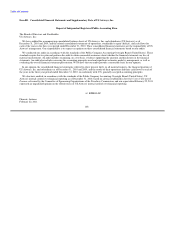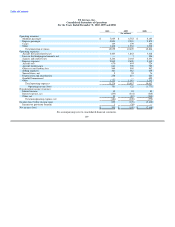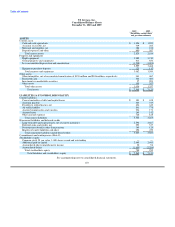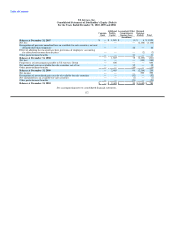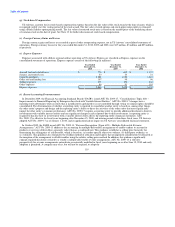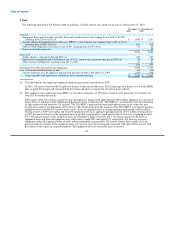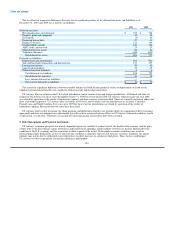US Airways 2010 Annual Report Download - page 118
Download and view the complete annual report
Please find page 118 of the 2010 US Airways annual report below. You can navigate through the pages in the report by either clicking on the pages listed below, or by using the keyword search tool below to find specific information within the annual report.
Table of Contents
transportation component requires estimates and assumptions that require management judgment. Significant estimates and assumptions
include:
• the number of awards expected to be redeemed on US Airways;
• the number of awards expected to be redeemed on partner airlines;
• the class of service for which the award is expected to be redeemed; and
• the geographic region of travel for which the award is expected to be redeemed.
These estimates and assumptions are based on historical program experience. The transportation component is deferred and amortized
into passenger revenue on a straight-line basis over the period in which the mileage credits are expected to be redeemed for travel, which
is currently estimated to be 33 months.
Under the residual method, the total mileage sale proceeds less the transportation component is the marketing component. The
marketing component represents services provided by US Airways to its business partners and relates primarily to the use of US Airways'
logo and trademarks along with access to US Airways' list of Dividend Miles members. The marketing services are provided periodically,
but no less than monthly. Accordingly, the marketing component is considered earned and recognized in other revenues in the period of
the mileage sale.
As of December 31, 2010 and 2009, US Airways had $178 million and $212 million, respectively, in deferred revenue from the sale of
mileage credits included in other accrued expenses on the consolidated balance sheets. For the years ended December 31, 2010, 2009 and
2008, the marketing component of mileage sales recognized at the time of sale in other revenues was approximately $144 million,
$112 million and $126 million, respectively.
US Airways is required to adopt and apply Accounting Standards Update ("ASU") No. 2009-13, "Revenue Recognition (Topic 605) –
Multiple-Deliverable Revenue Arrangements," to any new or materially modified business partner agreements entered into on or after
January 1, 2011. See Note 1(t) for more information on recent accounting pronouncements.
(l) Derivative Instruments
US Airways has from time to time utilized heating oil-based derivative instruments to hedge a portion of its exposure to jet fuel price
increases. These instruments consisted of no premium collars. All derivatives were marked to fair value on the balance sheet with
adjustments to fair value recorded in the income statement. Since the third quarter of 2008, US Airways has not entered into any new
transactions to hedge its fuel consumption, and US Airways has not had any fuel hedging contracts outstanding since the third quarter of
2009. See Note 5(a) for additional information on US Airways' fuel hedging instruments.
(m) Deferred Gains and Credits, Net
In 2005, US Airways' co-branded credit card provider, Barclays Bank Delaware, formerly Juniper Bank, paid AWA $150 million in
bonuses, consisting of a $20 million bonus pursuant to AWA's original credit card agreement with Juniper and a $130 million bonus
following the effectiveness of the merger, subject to certain conditions.
In the event Barclays, at its option, terminates the amended agreement prior to March 31, 2013 due to US Airways' breach of its
obligations under the amended credit card agreement, or upon the occurrence of certain other events, then US Airways must repay a
portion of the bonus, which declines monthly according to a formula. US Airways will have no obligation to repay any portion of the
bonus payments after March 31, 2013.
At the time of payment, the entire $150 million was recorded as deferred revenue. US Airways began recognizing revenue from the
bonus payments on April 1, 2009. The revenue from the bonus payments will be recognized on a straight-line basis through March 31,
2017, the expiration date of the amended Barclays co-branded credit card agreement.
Also included within deferred gains and credits, net are amounts deferred and amortized into future periods associated with the sale
and leaseback of property and equipment, the adjustment of leases to fair value in connection with prior period fresh-start and purchase
accounting and certain vendor incentives.
117



